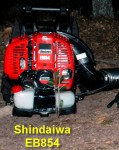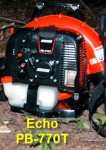Putting together a commercial blower review without these two companies products would have been wrong. Many readers had asked for us to take a look at the larger units these two companies produce and after testing them, we are glad we did. Since the other units our testers reviewed had opened up their eyes to blowers not currently in their racks, they were eager to try these out also.

I had heard many good things about the Shindaiwa model EB854 RT before testing it. After using the 854, I must admit that it lived up to expectations. Echo asked us to take a look at the 770T and we found it to be an outstanding unit also. Looking at the Shindaiwa and Echo units you can see similarities in design. The same can be said for Husqvarna and Red Max units. Shindaiwa employs several features that are designed to prevent overheating from intake clogging. The first being an intake cover designed to prevent clogging and the second is an overheat switch that shuts the unit down if the engine overheats . We did not have any issues with the intake clogging. Echo employs a leaf guard and again, no user encountered problems with intake clogging.

The performance of the Echo 770T (Manufacturer’s Page) and the Shindaiwa EB 854( Manufacturer’s Page) was in line with the other tested machines. Bear in mind the performance at this level of machines is top of the line, and where these machines differentiate themselves from earlier blower models is really seen when working with wet, water logged leaves and wet grass clippings. I found the Shindaiwa had a slight edge when used to move wet leaf mold. The difference is slight, not enough to base your purchase decision on. The Shindaiwa 854 and the Husqvarna 380 BFS seemed to handle the wet stuff a little better than the other units. For users in areas where noise abatement laws exists or areas where sound ordnances are in place, Shindaiwa has a feature that slows the motor down and decreases the db level, a really nice feature for noise sensitive areas.
One feature of the Echo that everyone seemed to agree on was the ventilation of the backpack area by circulating air through the backpack area. Echo did not overlook the fact that in many areas a commercial blower is used more often to clean after lawn mowings. Cutting lawns is normally a warm or hot weather activity and the air circulation does make a big difference. RedMax also employs this feature and we highly recommend it for purchasers in areas where the blower will be used in warm weather.
Both the Echo and the Shindaiwa meet or exceed EPA Emissions Standards. The manufacturers listed specs for these machine’s performance are, the Echo Pb-770T puts out 765 cubic ft/min and Shindaiwa claims 760 cubic ft/min. We feel the CFM standard is a truer measure of performance than MPH. If you need more MPH get a smaller tube. Looking back to our earlier model reviews we see that Stihl BR-600 list 712 CFM in tube, Husqvarna shows 685 CFM for its model 380BFS and RedMax has 586 CFM for its model 7150. One of the units we were unable to test was RedMax’s 8150 which produces 685 CFM in pipe. Compared to 530 CFs put out by a Stihl 550 the industry standard here in the South, you can see the significant performance gains of these top of the line units.
Throttle location on these units was located on the blower tube, right hand side discharge except for the RedMax with its throttle location on the drop down stick mounted to the left side of the frame. Some preferred this layout, others preferred the throttle mounted onto the blower tube. I grew to like the throttle mounted on the left side better. All units have cruise control to keep you from enduring muscle cramps in your hand from working the trigger constantly.
Fuel filler location varies on the models. The extended filler necks on the units minimize fuel spills, but some users were concerned that exposed necks are more likely to break or become cracked during rough use and transportation. Again we had no problems with this occurring during our test. Stihl located its fuel filler on the left side tucked neatly into its frame, yet accessible.
The weights on these units fall between the Stihl BR-600 on the light side at 21.6 pounds and the Husqvarna weighing in at just under 30 pounds. Shindaiwa list 25.4 pounds dry weight and Echo lists the PB-770 at 23.8 pounds.
Overall these units are each capable of handling day-in/day-out use in a commercial setting. Landowners needing the extra performance the baddest blowers in the county should be happy with any of these units. If you are a small framed person, then consider the weight factor. However, a well designed backpack frame can make up for additional weight. The addition of a hip belt shifts the load to the hips, and as any experienced backpacker will tell you, a well designed hip belt makes all the difference in the world. So we advise to actually try on the various models to see which model fits best, and if possible arrange a demo test. That being said which of these units would best serve your needs? If you are happy with a particular brand and want to stick with it, then opt for that brand. If you are looking for something different than what you currently use, we recommend talking to your local dealers and choosing a brand where you feel the dealer will stand behind the product. For more information on our earlier tests of the Husqvarna 380 BFS, Stihl BR600 and the RedMax 7150 see here.



